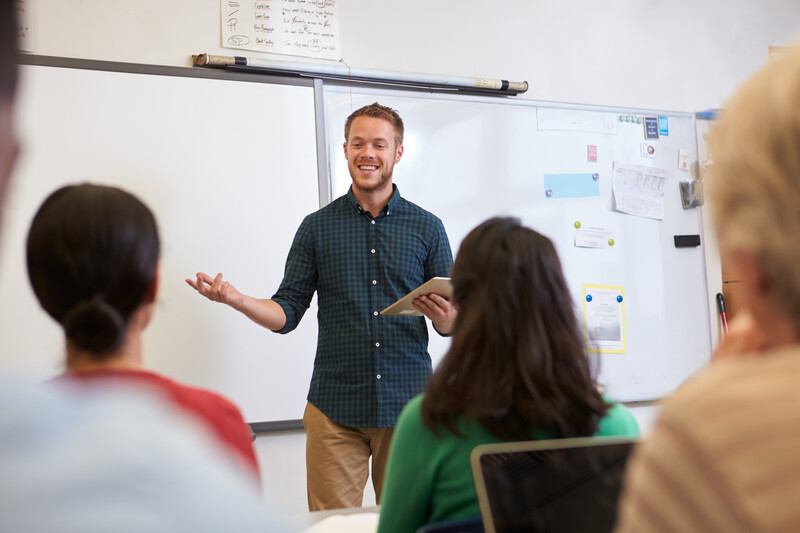What differentiates classrooms in which students make the most progress from those in which they make the least? Several current frameworks have attempted to answer that question by naming the practices of skillful teachers (see Danielson, 2007; Lampert, 2001; Lemov, 2010). Identifying the specific practices fundamental to supporting student learning is at the heart of building an effective system for the professional training and development of teachers.
Two contemporary factors intensify the need for such training. First, students are, more than ever, expected to achieve ambitious goals that include producing disciplined reasoning and solving problems, not simply recalling basic information and procedures. Second, the explicit aim is thatall students will achieve these outcomes. Although schools have always taught some students a more ambitious curriculum, they have traditionally set different goals for other groups of students. In contrast, teachers today are expected to help a much wider range of learners reach complex levels of performance. It is crucial, then, to identify the high-leverage practices that underlie teaching complex content to all students.
The "Unnaturalness" of Teaching
Teaching is one of the most common—and also one of the most complicated—human activities. Despite the prevailing view of teaching as requiring little more than patience, basic content knowledge, and liking children, teaching is "unnatural" work; that is, the skills involved in teaching do not come naturally (Jackson, 1986; Murray, 1989). They are distinct from informal showing, telling, or helping (Cohen, in press) in three fundamental ways.
Specialized Expertise
At its heart, teaching involves being able to "unpack" something one knows well to make it accessible to and learnable by someone else. This requires explicit knowledge and skill, beyond simple expertise. A tennis player with an amazing serve, for example, does not automatically know what goes into producing it. A native speaker of Spanish does not, while speaking fluently, readily notice the nuances of syntax or key semantic or grammatical features; nor do good readers necessarily see what they are doing to read and interpret complex texts. Being accomplished in a specific domain does not automatically include the capacity to break that domain down into its core components for someone who does not yet have that skill or understanding.
In fact, expertise depends on a high degree of fluency. Accomplished practice requires automaticity with many elements to enable careful attention to its less routine aspects. A writer who had to puzzle about simple grammar or word meanings could not focus on the intricate challenges of composition. A runner who had to think about the movement of her legs while running the final 25 yards of a race would be distracted from executing a skilled performance. A pianist who focused on the coordination of his hands would be unable to play smoothly. Teaching is unnatural in that it demands not only skill in a given domain, but also the ability to take that skill apart so others can learn it.
The Challenge of Multiple Perspectives
Teaching is unnatural in a second fundamental way. Because teachers must help others learn, they must see ideas and skills from others' perspectives. And their students often learn differently from the way they themselves learn. Even if a teacher remembers what helped her solve linear equations, write a good paragraph, or understand the concept of gravity, this may not help her students.
Figuring out what others find difficult or intriguing or how experience shapes their interpretations is far from simple. And yet teaching without attention to learners' perspectives and prior knowledge is like flying a plane in fog without instruments. This has big implications for equitable education because the greater the differences between learners and their teachers—in culture, language, and experience—the less precisely attuned the teaching is likely to be.
Working with Many Learners
Knowing a domain well enough to teach it and seeing it from someone else's perspective are hard enough when tutoring. But unlike many other professions, where the "clients" are serviced individually, teachers work with theirs in batches (Jackson, 1986). Not only do teachers have more learners to understand and interact with, but they also must design and manage a productive environment in which all are able to learn. One student requires a firm hand and a great deal of direction whereas another works best when left to puzzle further on his own. One student is active—tapping her pen, doodling, and rocking on her chair—even while deeply engaged whereas a second is easily distracted.
Differences show up inside the content, too. For example, although five students might correctly explain why .6 is greater than .45, eight others might get the answer right but for reasons that will fail when the numbers are more complicated. Noticing this difference requires careful listening to the students' answers. Attending to these differences while steering toward ambitious learning goals is no simple task.
Winging It Doesn't Work
Teaching is work that the United States expects 4.4 million people to do every day. It demands special kinds of knowledge and skill that most individuals do not naturally possess. Therefore, training teachers for actual practice—to master these unnatural skills—is crucial. Although many factors contribute to underperforming schools, the lack of an adequate system to train people for practice is at the heart of the problem.
The practice of teaching effectively is learnable, and we owe it to ourselves to ensure that those who teach our youth have appropriate opportunities to develop the necessary skills and knowledge. Students whose teachers do not develop these qualities lose out.
So how do we decide what to teach teachers? Among the well-worn responses are the domains of knowledge that fill many teacher preparation programs: academic subject matter, educational psychology, methods of teaching, foundations of education, and so on.
Academic content knowledge would seem the most obvious—how can teachers teach what they do not know? But developing adequate subject-matter knowledge is far from easy. Too little attention has been paid to the special demands of opening up to learners ideas and practices connected to specific subject matter (Ball & Forzani, 2010; Ball, Hill, & Bass, 2005; Ball, Thames, & Phelps, 2008). Many take for granted that educated adults know and can unpack the subtle ideas and processes of a field. This, however, is not usually the case.
Moreover, although including all these knowledge domains in teacher preparation may make sense, they leave open the endemic gap between knowing about teaching and doing teaching. Knowledge about child development does not necessarily enable a teacher to interpret a child's ideas; knowledge about social inequality does not necessarily transfer to teaching in ways that promote equity. Teachers have typically bridged the knowing-doing gap by having experience and improvising.
Certainly experience with youth in real classrooms can build skill with this complicated work. Experience, however, is an undependable source of learning, and individual discretion in the name of creativity can be a risk. Some teachers left to learn through experience manage their classrooms using harshly punitive methods; others attempt to solve difficulties with complex content by providing learning aids, such as mnemonic devices, that enable students to get the right answers but that circumvent actual learning. Some teachers who "naturally" favor particular students treat students inequitably. Many teachers simply make up their own ways of doing things without evidence of the effectiveness of their approaches.
Identifying High-Leverage Practices
Given the size of the teaching force and the nonintuitive qualities of the work, we need to identify a common set of high-leverage practices that underlie effective teaching and to develop ways to teach them. By high-leverage practices, we mean those practices at the heart of the work of teaching that are most likely to affect student learning. One example is conducting a meeting with a parent or guardian about a difficult situation with a child. Another is identifying common patterns of student thinking in specific subject matter—for example, upper elementary children's misconceptions about the equal sign, young learners' ideas about "living" versus "nonliving" things, or adolescents' approaches to interpreting the motives and thinking of people in the past.
High-leverage practices comprise the essential activities of teaching; if teachers are unable to discharge them competently, they are likely to face significant problems. Competent enactment of such practices also lays the foundation for beginning teachers to develop into highly effective professionals (Teacher Education Initiative Curriculum Group, 2008).
Identifying a set of core high-leverage practices involves managing three endemic problems.
The Content-Specific Nature of Teaching
High-leverage teaching practices are intimately tied to specific domains. For example, consider two such practices: Framing and delivering questions precisely and purposefully and eliciting and interpreting displays of student understanding. A good question sequence in a history class is different from one in a mathematics lesson. As Grossman and McDonald (2008) observed, we have little formal knowledge about how the work of teaching differs from one subject to the next. However, we can discern that in a history class, teachers ask students to evaluate the credibility of different sources and consider factors that shape their reliability. Mathematics teachers request and support mathematical explanations, which are different from historical or scientific ones. Designing a prompt to assess students' developing writing is different from constructing a task to elicit students' learning about a scientific idea, such as force or light.
All of this is complicated by the expectation for teaching complex knowledge and skills. It's one thing to ask a question that prompts students to reduce an improper fraction or to figure out the meaning of an unfamiliar word. It's entirely another thing to pose questions designed to support students' efforts to prove a mathematical claim or analyze data.
The Cultural Context
Classroom instruction is also situated in specific cultural contexts, which place differing demands on the teacher. Introducing 9th graders to the work of Maya Angelou may be a somewhat different task in a suburban Connecticut classroom than it is in a classroom in rural Mississippi. Students in each location bring differing degrees of familiarity with Angelou's context and language and may make different interpretations of the text. Expectations and norms for communicating with parents and colleagues might also vary.
Working at a Useful Grain Size
In other professions, from aviation to medicine to cosmetology, professionals are trained to carry out specific elements of their work. Prospective pilots learn how to execute takeoffs, landings, and turns; medical students learn how to conduct a physical examination and dress a wound; hair stylists learn how to precisely scissor layers into different textures and lengths of hair. Whereas other trades and professions have been able to break their work into meaningfully learnable skills and knowledge, educators have—amazingly—not done this for teaching.
Certainly, examples exist of efforts to describe teaching in terms of its core skills. In the 1970s, competency-based teacher education programs trained teachers in hundreds of "competencies" (Houston & Howsam, 1972). These focused on specific teacher behaviors, such as giving praise, using wait time, and calling on students. However, three problems arose with this approach. First, the lists contained microskills from which it was not obvious how to compose skilled practice. Second, these skills were often content-free. Although some specific practices were identified within subject areas (for example, techniques and tools for assessing students' reading proficiency or skills for teaching counting to young children), these tended to center on basic, primary-level reading and math instruction. Third, inattention to the judgments needed to deploy these skills in context made it difficult to know when a particular practice would be appropriate and how a teacher might use it.
Competency-based teacher education programs were criticized for being too behaviorist; teaching, obviously, depends on significant cognitive and ethical reasoning as well as manner and style (Fenstermacher, 2001). Still, the movement represented an important effort to acknowledge the fact that teaching is a practice that requires skilled technique and action, not merely a domain of knowledge or an arena for individual creativity.
Grossman and colleagues (2009) refer to this process of identifying the core elements of teaching as "decomposition of practice." Not surprisingly, they found that a language of practice is less well developed in teaching than it is in other fields. For example, although teachers use questions continually, no common, precise vocabulary exists for particular types of questions, purposes, or learning activities within a content domain. Questions that teachers use to elicit students' thinking—such as, What have you found so far? Can you explain how you got your answer?— are different from ones they might use to challenge or extend their students' thinking—such as, What if someone said that 8/8 is greater than 5/5 because there are more pieces?
Managing the problem of choosing a useful grain size that gets inside the work of teaching is not easy. A first step is to identify the tasks that are fundamental to effective teaching. Examples include figuring out and responding to what students say, launching a task in class, checking quickly on students' understanding, conducting a class discussion, or calling a parent about a difficult situation. Many attempts remain at too high a level of abstraction—"planning instruction," for example, or "designing instruction to address each student's learning needs," which is more a principle than a practice. Similarly, "engaging students in using methods of inquiry" is a goal but not a specific practice.
Asking what a teacher has to do to act on any of these can help identify actual practices at a useful grain size. For example, take the high-leverage practice of managing and conducting a wholeclass discussion. Doing this well is at the heart of the enterprise of teaching: unpacking the content for learning, attending to learners' thinking, and managing the group nature of teaching.
Figure
Specific practices involved in leading a discussion include specifying and using learning goals to keep the discussion focused on its point (Sleep, 2009), maintaining students' engagement, asking purposeful questions, carefully listening and responding to students, creating norms for talking and listening, choosing and guiding students' use of specific artifacts, connecting students' contributions, and tying up the discussion. Teachers who cannot marshal these skills effectively may be able to generate some collective talk in their classrooms but will be limited in their ability to use discussions to achieve specific learning goals.
In this case, simply accepting the correct answer "one-fourth" would shortchange students' opportunity for learning because it would neither require unpacking why "one-third" is a common incorrect answer nor help students think more carefully about what it means to identify a fraction (Saxe et al., 2007).
Figure
The first example opens up a core mathematical idea (equal area) whereas the second presents a much more routine case. Recognizing that, and being able to decide which example to use for a given purpose or how to sequence them, is essential for effective teaching. To do this ineptly is to be tone-deaf as a teacher.
Teachers' work is full of other instances of crucially important, complex, and "unnatural" practices, such as discussing a student's progress with a caregiver, writing careful feedback on a student's essay, or designing an assessment that will provide useful information to students and teacher alike.
The Teacher Education Initiative
At the University of Michigan, we are piloting a new model of teacher education, which is built on 19 high-leverage practices, as part of our Teacher Education Initiative. Drawing on research linking particular practices to student achievement, published descriptions of teaching, videos of teachers at work, and personal experience, a group of University of Michigan–based researchers, teachers, and curriculum developers created a comprehensive list that included more than 200 items. Because few studies have identified specific instructional practices that should be taught during initial teacher education, we also relied on wisdom of the profession and analysis of the demands of effective instruction. We narrowed our list to 19 practices that met our definition of high leverage, that is, practices that significantly increase the likelihood that teaching will be effective for students' learning. As we continue to engage in evidence-based evaluations of each practice over the next five years, we expect the list to evolve.
In our redesign of our teacher education program around these practices, we are elaborating each item to fit the details of teaching at particular levels or in particular subjects. How students learn to enact the practices will depend on whether they are preparing to be an elementary or a secondary teacher and what subjects they intend to teach.
For example, one high-leverage practice is the ability to recognize key ways of thinking, ideas, and misconceptions that students in a specific grade level typically have when they encounter a given idea. Elementary mathematics teachers should be able to examine student solutions to a complex subtraction problem and recognize how students arrived at the answers they did. High school English teachers should be able to recognize why some populations of students consistently use forms of subject-verb agreement that differ from standard English. Elementary science teachers should know that the process of photosynthesis frequently confuses 5th graders and understand why this process is difficult for learners to grasp.
Not all common patterns of student thinking involve errors; teachers should be able to recognize common ways that students think about content, including common resources they bring and predictable developmental changes they go through as they grow. For example, when young children begin to "count on"—that is, when they know instantly that there are nine items when one is added to a set of eight that they have already counted, as compared with their earlier practice of counting all over again—teachers should immediately recognize this significant step. Many urban black adolescents are likely to have deep experience of word play that can enhance their ability to engage in complex literary analysis (Lee, 2007), and teachers can harness middle schoolers' social preoccupations for productive collective work.
Identifying Common Ground
Even though learners differ and teachers must continually tailor instruction in response, the work of teaching is not wholly unpredictable. Much is common across learners, subjects, and contexts; and it could be shared, studied, and learned by all.
Consider what goes on in other professions. They too demand individual responsiveness, and yet broad idiosyncratic creativity would be neither tolerated nor appropriate. Surgeons do not invent techniques at their pleasure that fit their "style"; pilots do not creatively land planes. Of course, skilled practitioners flexibly adapt to conditions, but they do not make up practices according to their individual "way" of doing things. There is a professionally based bottom line: Surgeons must meticulously carry out procedures that result in high levels of success; pilots must land planes safely. Teachers, too, must teach skillfully so their students learn.
Identifying a set of practices that aims at complex outcomes for all students is a first step toward strengthening the teaching profession. These practices could provide a common foundation for teacher education, a common professional language, and a framework for appraising and improving teaching.









